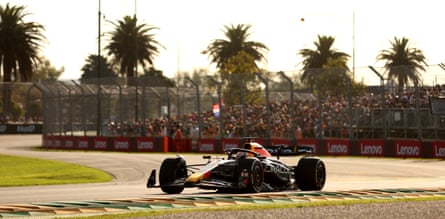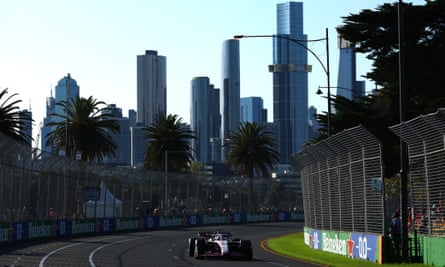Max Verstappen wins Australian GP as chaotic F1 race finishes ...
From fireworks to farce, what began at the Australian Grand Prix with illuminating excitement ended with the dampest of squibs. Inevitably, and with what is likely to become a relentless refrain this season, Max Verstappen won for Red Bull in Melbourne but only after a measure of the chaos and confusion that F1 seems exquisitely adept at serving up. Its labyrinthine rulebook once more weighed heavy on the action, informed by the looming spectre of the Abu Dhabi 2021 controversy and an intimation that the demand for entertainment is in the driving seat of decision making.
The meeting at Albert Park took a full two and half hours to conclude. Late risers in the UK hoping to catch the final laps over breakfast were doubtless pleased to find that there was still plenty of time left to watch after it was stopped no fewer than three times.
Whether they understood what was actually happening by the end is another question entirely as few it seems in Melbourne had much idea either, the race coming to a conclusion in an ignominious fashion, dismissed by drivers as a mess that left even them confused.
The second and key stoppage came with four laps to go, to deal with debris after Kevin Magnussen’s Haas clipped the wall at turn two and lost its right rear tyre. A standing restart followed and, with two laps to run, the pinnacle of motor racing descended into bedlam. Six cars were involved in incidents, flying into one another and off the track before the field had managed to reach the end of the first sector of the lap.
The red flag was shown once more and those that could returned to the pits, only for a further delay of over 30 minutes as the FIA leafed through their regulation documents to work out what should happen next. Time ticked on as the sun sank lower in the sky, the self-proclaimed fastest sport in the world proceeding at a torturous pace and everyone willing these painful final moments to be put out of their misery.
Finally, over it was. The pack trotted out for one lap behind the safety car to complete race distance and a bemused Verstappen took the flag from Lewis Hamilton and Fernando Alonso.

There were winners and losers in the process of those final decisions, of course. Not least in the finishing order being decided by how the pack had begun the final restart, minus the cars that had crashed, if anyone at that point could keep up with the Kafkaesque protocols. However, that it should ultimately end behind the safety car was almost poetically ironic.
F1 and the FIA have long been eager to avoid races coming to a close in a train behind the safety car. It was an imperative that drove the decision making at Abu Dhabi in 2021, when Michael Masi, the race director, improvised around the rules to such costly effect that it denied Hamilton his eighth title and ensured Verstappen his first.
There was some consensus afterwards that a red flag should have been shown at the time, the FIA concluded that there had been “human error” and Masi was removed from his post. The Australian, who made his first return to the F1 paddock this weekend, was there to witness the consequences as it is impossible not to observe that, since 2021, there has been a distinct proclivity to throwing a red flag sooner rather than later.
Abu Dhabi’s influence is still felt and indeed has since been further compounded. There were questions about whether the drama was being exaggerated to appease the new audience F1 has attracted thanks, in part, to the TV show Drive to Survive. This fanbase, it is felt, would not take kindly to the gladiatorial sport they have been sold on Netflix piffling round in a procession for the final laps behind a safety car.

The FIA cites safety as the paramount reason behind stopping a race, but it is also unquestionable that standing starts after a red flag add to the drama and spectacle. Some drivers, including McLaren’s Lando Norris, explicitly suggested they were being employed to make the “show more exciting”.
The drivers said they would be raising the issue with F1 and the FIA before the next round in Baku but, from the disarray, the overwhelming sense was that there is a lack of transparency over what provokes a safety car or a red flag, especially in the late phases of a race.
It is a furore that is unlikely to die down swiftly and one that overshadowed what was otherwise a formidable performance by Verstappen and Red Bull. In a gripping opening he was passed by George Russell and Hamilton but, after the race’s first red-flag stoppage, came off the leash and swept back into the lead. He was at one point 11 seconds clear of Hamilton and cruising, the Red Bull’s straightline and cornering speeds absolutely exceptional. The world champion may have felt disappointed about how the victory was clinched but, by and large, it was as markedly emphatic as the decision making in the final third was abstruse.
Lance Stroll was in fourth for Aston Martin. Red Bull’s Sergio Pérez finished fifth after coming back from starting at the back of the grid. Australia’s Oscar Piastri scored his first F1 points in his debut home grand prix, finishing in eighth place. Norris was in sixth for McLaren, Nico Hülkenberg in seventh for Haas, Guanyu Zhou in ninth for Alfa Romeo and Yuki Tsunoda in tenth for AlphaTauri.























































